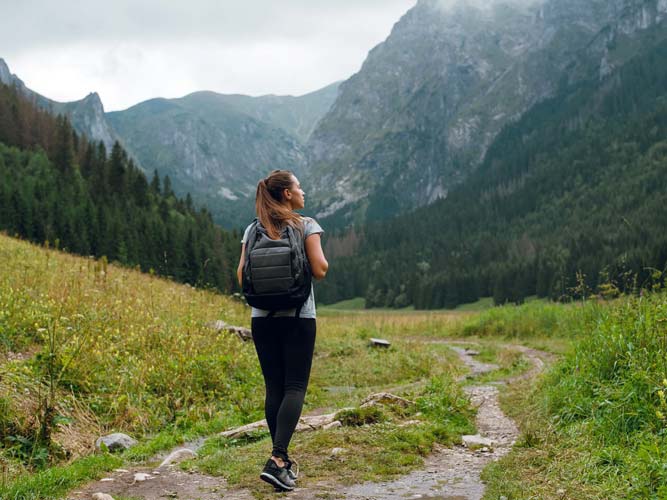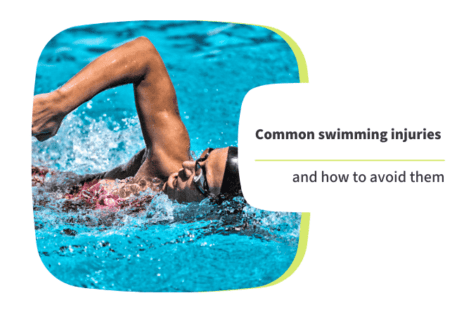7 tips to help avoid injuries while hiking

Hiking is a wonderful way to exercise and experience the beauty of the outdoors. You can discover the wonders of nature at whatever pace you’re comfortable with, and with a little planning and preparation, it’s an activity that almost anyone can do.
Avoid injuries while hiking
If you are in pain from hiking, it could be a sign of an injury or a chronic condition. Continue reading to help avoid injuries while hiking:
- Find an easy hike
- Wear proper clothing/footwear
- Check the weather
- Use hiking poles
- Be prepared with first aid
- Train
- Proper nutrition
1. Find an easy hike
If you are new to hiking, find a hiking partner and start with an easy hike. Distances less than five miles with relatively flat terrain and minimal climbing is a great way to go. In other words, do not start out with a summit of Mt. Everest! You can challenge yourself with longer and more difficult hikes as you become more comfortable and build your fitness.
2. Wear proper clothing/footwear
- Clothing: Dressing in layers to adjust for temperature changes throughout the day is key to not getting overheated or too cold. Comfortable, breathable, and quick drying materials are preferred. Do not wear jeans and pack a light rain jacket for those unexpected showers. A wide brim hat and/or buff can help prevent sunburn.
- Shoes and socks: A comfortable trail running shoe or hiking boot for added ankle support is the best way to go. You may want to get a shoe 1/2 size bigger than normal to accommodate for normal foot swelling throughout the day. Do not go out in a new shoe without an adequate “break in” period. Blisters on the trail are no fun! Avoid cotton socks if possible as they hold moisture and are more likely to cause blisters. Merino wool is a great sock material, and a sock liner can be helpful to prevent blisters.
3. Check the weather
Know predicted temperature changes and chances of rain/snow. This will affect how you need to dress and will also determine if your hike should be rescheduled due to adverse trail conditions.
4. Use hiking poles
Using hiking poles can significantly reduce the risk of injuries while hiking for several reasons. Firstly, trekking poles help distribute weight and absorb shock, which alleviates stress on the knees and joints, especially during descents where the impact is greatest. Secondly, they enhance stability and balance, providing additional points of contact with the ground that can help prevent falls on uneven or slippery terrain. Additionally, using trekking poles encourages a more upright posture, which can improve breathing and overall comfort during hikes, further contributing to injury prevention.
5. Be prepared with first aid
Always let a friend or family member know where you are hiking in case of an emergency. Leave a hiking itinerary in your vehicle near the trailhead in the event that you are unable to make it back. If you are in an area with no cell signal, then plan for alternate ways to communicate (satellite phones, etc.). Always carry a map of the area. GPS is also a great resource if available. Your first aid kit should include items such as basic wound care, blister treatment such as moleskin and anti-chafing rub, sunscreen, bug spray, flashlight/headlamp, and an emergency blanket.
6. Train
Choose a hike that matches your level of fitness. If you are not accustomed to the terrain or distance, then you will need to train ahead of time to prepare. If you are going to be hiking through elevation changes, then it is recommended to spend time strength training your legs (squats, lunges, box step-ups) and incorporating stair training or stadiums. Make sure that you do some of your training in your gear as to best simulate the challenges of the hike (wear your backpack while walking, wear your hiking shoes, etc.)
7. Proper nutrition
Make sure to pack plenty of water and snacks. It’s always better to pack more than you think you’ll need. Hydration is very important. Make sure that you prehydrate before leaving the vehicle and know where all potential water sources are on the trail. Potable water may not always exist, and in this case, you will need to either pack all your water (which increases backpack weight) or bring water filtration/treatment gear. Snacks should be calorie-dense and have a low weight burden. Common items include dried fruit, nuts, jerky, protein bars and granola.
By: Dr. Bryan Prine & Dr. Michael Seth Smith
Get convenient, comprehensive care at Florida Orthopaedic Insitute
Whether you have an injury from hiking or any other physical activity, we can help. The care team at Florida Orthopaedic Institute includes experts in every aspect of orthopedics. If you’re having discomfort, let us create a customized treatment plan to help you—safely—get back into action and keep active.
Don’t wait to schedule an evaluation with a specialist at one of our many convenient locations in Central Florida. Call us or go online today to book an appointment.
You might also like:
- Dr. Christopher Baker on Fox 13: Preventing Pickleball Injuries
- Trick or treat save your feet: 7 must-know tips for healthy feet and ankles this Halloween
- 6 signs you might have a pickleball knee injury
About Florida Orthopaedic Institute
Founded in 1989, Florida Orthopaedic Institute is Florida’s largest physician-led orthopedic group. It provides expertise and treatment of orthopedic-related injuries and conditions, including adult reconstruction and arthritis, foot and ankle, general orthopedics, hand and wrist, orthopedic trauma, shoulder and elbow, spine, interventional pain management, sports medicine, podiatry, physical medicine and rehabilitation, chiropractic services, and physical and occupational therapy, among others. The organization treats patients throughout its surgery centers in North Tampa, South Tampa, and Citrus Park, at several orthopaedic Urgent Care centers and at office locations in Bloomingdale, Brandon, Citrus Park, Gainesville, Lakeland, Northdale, North Tampa, Ocala, Palm Harbor, Riverview, South Tampa, Sun City Center and Wesley Chapel.
November 15, 2024


